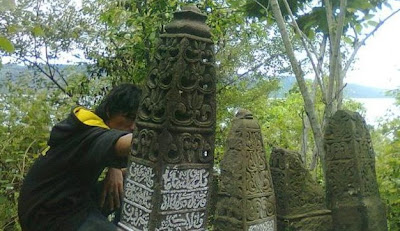Sanghyang Dance (Trance Dance) is a sacred dance in Bali, Indonesia, because the dance done by the action of spirits, good spirits and animal spirits dedari who have supernatural powers. This dance is a cultural heritage of pre-Hindu aimed refused Reinforcements. Sanghyang dance is a dance of spiritual communication with the supernatural community to sing worship songs to the accompaniment of the Gending (Bali traditional music). In this dance there are always three important elements namely fire, sanghyang music and dancers. And sanghyang dance that common staged in Bali comprises; Sanghyang Dedari, Sanghyang Deling, Sanghyangg Bojog, Sanghyang Jaran, Sanghyang Sampat and Sanghyang Celeng.
Sanghyang Dedari
Sanghyang Dedari dance, performed a pair of dancers who previously consecrated and sung gending sanghyang dedari unconscious dedari sprit who entry sign, where both dancers are dancing in a trance dancing on stage surrounded the man's shoulder. The purpose of the dance performances sanghyang dedari is begging safety from natural disasters or disease outbreaks. This dance of the region, Badung, Gianyar and Bangli.
Sanghyang Deling
Sanghyang Deling dance pair of girls who have danced puberty, this dance entered the spirit of Lord Vishnu or Dewi Sri symbolizes fertility. By means of a tree hung with two dolls called deling, that maked from palm leaves. The more the hardness of motion of the two dancers deling signifies proficiency level has conceded the spirit, purpose is to apply the safety dance. This dance is only found in the village of Kintamani, district Bangli.
Sanghyang Bojog
Sanghyang Bojog dance is danced by a man to dress like a monkey. Formerly calling spirit ceremony ape, after conceding dancer spirit dancer proficiency level will then jumping on top of the tree monkeys imitate gestures, sometimes it's hard to imitated by humans. Sanghyang Bojog dance is in Karangasem regency.
Sanghyang Jaran
Sanghyang Jaran is danced by a man riding a rocking horse made of palm leaves sheath. After the ceremony and the dancers are possessed by the spirits of the gods paradise saddler, dancers will walk and trot with leg without slippers, and stepped coconut shell embers were prepared in the arena sanghyangg dance lesson. This dance done when people were concerned about the state of this nature. Sanghyang Jaran dance is located in Badung regency, Denpasar, Gianyar and Bangli district.
Sanghyang Sampat
Sampat sanghyang dance is danced by a girl who has entered into the spirit with a broom or stick intermediaries who digerak movement from left to right or vice versa, or run out of the other intermediaries using a piece of bamboo with the title sanghyangg tube.
Sanghyang Celeng
Sanghyang Celeng dance is danced by a man with a dress made of fibers that resemble pigs (celeng means a pig). After the dancers entered the spirit, the dancers will crawl mimic the behavior of a pig. These dances are Duda village, Karangasem regency.
Sanghyang Dedari
Sanghyang Dedari dance, performed a pair of dancers who previously consecrated and sung gending sanghyang dedari unconscious dedari sprit who entry sign, where both dancers are dancing in a trance dancing on stage surrounded the man's shoulder. The purpose of the dance performances sanghyang dedari is begging safety from natural disasters or disease outbreaks. This dance of the region, Badung, Gianyar and Bangli.
Sanghyang Deling
Sanghyang Deling dance pair of girls who have danced puberty, this dance entered the spirit of Lord Vishnu or Dewi Sri symbolizes fertility. By means of a tree hung with two dolls called deling, that maked from palm leaves. The more the hardness of motion of the two dancers deling signifies proficiency level has conceded the spirit, purpose is to apply the safety dance. This dance is only found in the village of Kintamani, district Bangli.
Sanghyang Bojog
Sanghyang Bojog dance is danced by a man to dress like a monkey. Formerly calling spirit ceremony ape, after conceding dancer spirit dancer proficiency level will then jumping on top of the tree monkeys imitate gestures, sometimes it's hard to imitated by humans. Sanghyang Bojog dance is in Karangasem regency.
Sanghyang Jaran
Sanghyang Jaran is danced by a man riding a rocking horse made of palm leaves sheath. After the ceremony and the dancers are possessed by the spirits of the gods paradise saddler, dancers will walk and trot with leg without slippers, and stepped coconut shell embers were prepared in the arena sanghyangg dance lesson. This dance done when people were concerned about the state of this nature. Sanghyang Jaran dance is located in Badung regency, Denpasar, Gianyar and Bangli district.
Sanghyang Sampat
Sampat sanghyang dance is danced by a girl who has entered into the spirit with a broom or stick intermediaries who digerak movement from left to right or vice versa, or run out of the other intermediaries using a piece of bamboo with the title sanghyangg tube.
Sanghyang Celeng
Sanghyang Celeng dance is danced by a man with a dress made of fibers that resemble pigs (celeng means a pig). After the dancers entered the spirit, the dancers will crawl mimic the behavior of a pig. These dances are Duda village, Karangasem regency.



















